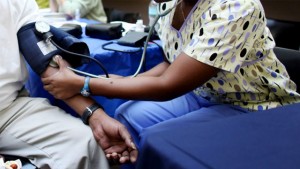 TOKYO, Japan, Thursday May 14, 2015 – The discovery of a key mechanism in the cells which helps healthy people regulate their blood pressure naturally could lead to the development of new drugs to slash the risk of heart attacks and strokes.
TOKYO, Japan, Thursday May 14, 2015 – The discovery of a key mechanism in the cells which helps healthy people regulate their blood pressure naturally could lead to the development of new drugs to slash the risk of heart attacks and strokes.
Scientists at the Riken Brain Science Institute in Japan discovered that blood pressure is dramatically reduced when a specific protein, ERAP1, is released from cells and enters the bloodstream.
The finding could lead to a medication for people with hypertension (high blood pressure), who are at a higher-than-usual risk of strokes, heart attacks and type 2 diabetes.
In research published in the journal Molecular Cell, the Japanese scientists found that the protein works by breaking down a key hormone called angiotensin II, a peptide chemical that causes blood vessels to constrict.
Blood pressure is raised as the arteries and veins tighten. The ERAP1 protein counters this effect by digesting the hormone, reducing its levels in the bloodstream, and preventing it constricting the blood vessels.
According to lead researcher Dr Katsuhiko Mikoshiba: “With this new discovery we now know more about how angiotensin II is normally removed from the blood to lower blood pressure, and we have a new system to study for potential therapies.”
The breakthrough was made after researchers discovered that mice with high levels of the ERAP1 protein had unusually low blood pressure.
“We noticed that the mice had similar defects to those that lack angiotensin II – the peptide hormone that acts to raise blood pressure,” researcher Chihiro Hisatsune said.
“We measured their blood pressure and were surprised to find it was about 20 percent lower than in normal mice.”
Medications currently prescribed for hypertension include some that target the enzyme that produces angiotensin II.
The Japanese research team hopes that a new medication may be more effective. Instead of stopping the production of the hormone, it would boost a naturally occurring mechanism that reduces its concentration in the bloodstream to normal levels.
“Current therapies for hypertension target the enzyme that produces angiotensin II,” said Mikoshiba.
“Our results open the door to alternative approaches that target the activity of proteins like ERAP1.
“We hope our results can lead to the development of new strategies for treating people with blood-pressure disorders.”
